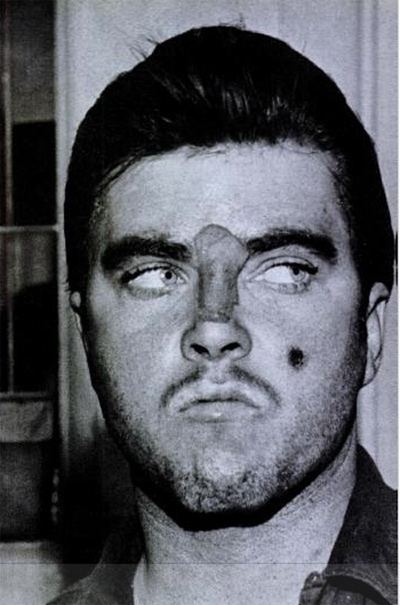Name Charles Schmid | ||
 | ||
Born July 8, 1942 (age 32), Tucson, Arizona, U.S. Died March 30, 1975 (aged 32) Florence, Arizona, U.S. Similar Joyce Carol Oates, Arthur Gary Bishop, Charlie Brandt | ||
Charles Howard 'Smitty' Schmid, Jr. (July 8, 1942 – March 30, 1975), also known as "The Pied Piper of Tucson," was an American serial killer. His crimes were profiled by journalist Don Moser in his article "The Pied Piper of Tucson", featured in the March 4, 1966 issue of Life magazine and are the basis for "Where Are You Going, Where Have You Been?", a short story by Joyce Carol Oates. In 2008, The Library of America selected Moser's article for inclusion in its two-century retrospective of American True Crime.
Contents
- The Pied Piper of Tucson Charles Schmid
- Early life
- The murders
- Trial
- After incarceration
- Death
- In popular culture
- References

The Pied Piper of Tucson - Charles Schmid
Early life

Charles Schmid was an illegitimate child who was adopted by Charles and Katharine Schmid, owners and operators of Hillcrest Nursing Home in Tucson, Arizona. He had a difficult relationship with his adoptive father, whom Katharine Schmid later divorced. When Schmid tried to meet his birth mother, she angrily told him never to come back.

He did poorly in school, but was described as good-looking, intelligent and well-mannered. An accomplished athlete, he excelled at gymnastics and even led his high school to a State Championship, but quit the team his senior year.
Just before graduating, Schmid stole tools from the school's machine shop, and was subsequently suspended. He never returned to school. He began living in his own quarters on his parents' property and received an allowance of $300 a month. His parents left him to run on his own with a new car and a motorcycle. He spent much of his Time on Tucson's Speedway Boulevard, picking up girls and drinking with friends, although he tended to be a loner. His best friends were Paul Graff, who lived with him, John Saunders, and Richie Bruns.

Schmid was a short man who wore cowboy boots stuffed with newspapers and flattened cans to make him appear taller. He used lip balm, pancake makeup and created an artificial mole on his cheek. He was said to have been related to Bob Dylan. He also stretched his lower lip with a clothespin to make it resemble Elvis Presley's. He was called the "Pied Piper" because he was charismatic and had many friends in the teenage community of Tucson. Women liked him and he frequently met them at the Speedway area of Tucson. For a time, the members of his teenage coterie would keep the secrets of his murders.
The murders

On May 31, 1964, Charles Schmid decided to Murder Alleen Rowe, a high school student living with her divorced mother. Schmid's girlfriend Mary French had convinced Rowe to go out with Schmid's friend John Saunders, but Schmid had intended all along to murder Rowe, in order to know what it felt like to kill someone.

Schmid and his friends took Rowe to the desert, where Schmid and Saunders Murdered her. Before murdering Alleen, Schmid told Saunders to rape her, but he couldn’t do it, because Saunders was gay. While the murder occurred, Mary French was waiting in the car and listening to the radio. Afterwards the three buried her. When Alleen went missing, her father told her mother he felt she had been murdered and left in the desert. The mother, Norma Rowe, went to the police and was told that she needed more evidence before they could go looking in the desert.
One of Schmid's many girlfriends was Gretchen Fritz, daughter of a prominent Tucson heart surgeon and community leader. Schmid confided to Gretchen that he had murdered Alleen Rowe. There were also rumors that Fritz knew of an earlier, unsubstantiated murder that Schmid supposedly committed. When Schmid decided to break up with Fritz, she threatened to use the information against him. Schmid strangled Gretchen Fritz and her sister Wendy on August 16, 1965.
Schmid confided to his friend Richard Bruns that he murdered the sisters and showed Bruns the bodies, buried haphazardly in the desert. Bruns became increasingly afraid that Schmid was going to murder his girlfriend. Ultimately, Bruns had to go to Ohio because his girlfriend's parents were convinced that he was harassing her. Bruns stayed with his grandparents in Ohio and told them everything he knew about the murders, and flew back to Tucson to help with the investigation.
Trial
The mid-1960s media focused their attention on the Schmid case and trial. Life and Playboy magazines sent reporters to Schmid's trial. Time did features on contemporary life in Tucson and the murders of the young women. F. Lee Bailey, a "celebrity" attorney who was involved with the Boston Strangler and Sam Sheppard cases of the 1950s and 1960s, was brought in for consultation.
In 1966, Schmid was found guilty of murder and sentenced to death. Rowe's remains were found in 1967. When the state of Arizona temporarily abolished the death penalty in 1971, Schmid's sentence was commuted to 50 years in prison.
After incarceration
Schmid made a few failed escape attempts, finally succeeding on November 11, 1965, escaping with another triple murderer, Raymond Hudgens. They held four hostages on a ranch near Tempe, Arizona, for a time, ate at Sonic, then separated, and were finally recaptured and returned to prison.
In the early 1970s, he became interested in poetry. He sent his work from prison to a professor at the University of Arizona, Richard Shelton. “For all the wrong reasons, I critiqued his work and discovered that he was quite talented,” Shelton says.
Death
On March 10, 1975, Schmid was stabbed 47 times by two fellow prisoners. After losing an eye and a kidney, he is said to have died as a result of the attack on March 30, 1975, but his body was stolen from the morgue. Following his death, Schmid's mother chose the prison cemetery for his burial, believing if he was buried in a public cemetery, his tombstone might be defaced. He received a Catholic funeral at the prison, although he was not in the casket.
After Schmid's trial and conviction, Katharine Schmid and her second husband owed her son's legal team more money than they possessed. As a result, they ended up living in near poverty in Coolidge, Arizona.
In popular culture
In 1966, Joyce Carol Oates wrote the short story "Where Are You Going, Where Have You Been?", about a teenage girl being charmed and menaced by a predatory man; she was inspired in part by the Schmid case. Oates's story is dedicated to Bob Dylan. It was adapted into a 1986 film Smooth Talk, in which Schmid's character, Arnold Friend, is played by Treat Williams.
The 1971 movie The Todd Killings is based on the Schmid case as was the 1994 film Dead Beat and the 2005 film The Lost, adapted from a novel by Jack Ketchum.
Actress Rose McGowan's 2014 directorial debut, Dawn, was inspired by the events surrounding the murder of Alleen Rowe. It stars Tara Lynne Barr in the role of Dawn (Rowe), Hannah Marks as Mary French and Reiley McClendon as Schmid.
The YA thriller Half in Love with Death (Merit Press 2015) by Emily Ross was inspired by the Schmid case.
A Crime to Remember portrayed the case in the 2014 episode "The Pied Piper".
